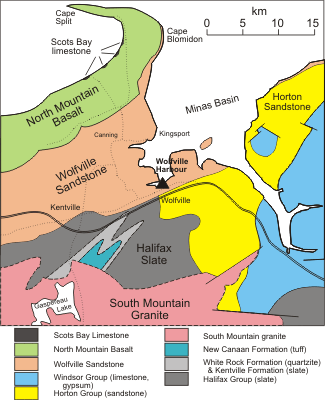Beckwith Dyke, West Side, Wolfville harbour
By J.A. Colwell & S.A. Ferguson
 LOCATION - The walk begins 210 m (700 feet) north
of Main
Street on Gaspereau Avenue Extension and continues westward along the
south side
of the Cornwallis River to the bridge at Port Williams.
LOCATION - The walk begins 210 m (700 feet) north
of Main
Street on Gaspereau Avenue Extension and continues westward along the
south side
of the Cornwallis River to the bridge at Port Williams.
ROUTE - Go north on Gaspereau Avenue Extension and follow the path on top of the dyke or the farm road beside the dyke.
DESCRIPTION - The dyke is an earth fill erected to keep out the sea and is maintained by the Nova Scotia Department of Agriculture. Material for the dyke is excavated from the river side by a large earth-moving machine. The most commonly used rock for protection of exposed parts of the dyke is White Rock quartzite. Because of continuing sedimentation the land level on the river side of the dyke is usually higher than on the landward side. On the Cornwallis River side there is a salt marsh which at high tide is partly or completely flooded and where salt tolerant plant flourish. On the upper salt marsh, which is only flooded by spring tides a few times a year, marsh hay predominates and formerly was harvested and piled on wooden structures called straddles above the levels of normal tides, some of which may still be seen. Cordgrass, which is taller with wider leaves, predominates in the lower saltmarsh. In the fall the dead leaves of the cord grass are washed into the estuary but the marsh hay forms a dense mat producing peaty material and a more fertile soil.
Water drains from the dykeland by means of "aboiteaux" which are concrete culverts with a hinged door. The door opens at low tide to allow fresh water to drain out and closed at high tide to keep out the salt water. The dykelands (polder) formerly were drained by ditches spaced about 15 m (50 feet) apart, which are inconvenient for present day machinery. A Canada/Nova Scotia development plan for marsh drainage improvement now uses the natural drainage pattern with fewer ditches and increasing the height of the land between water courses.
When a saltmarsh is first dyked it takes at least two years for the natural precipitation to leach out the salt before it is usable for agriculture. The soils of the dykeland are organically rich to silty loam. Poor drainage and susceptibility to frost are limiting factors for agriculture so that the uses are mainly for hay, pasture and crops such as oats and corn.
Reference: Anon, 1987. Maritime Dykelands. Nova Scotia Department of Agriculture and Marketing. Available from Nova Scotia Government Bookstore, 1700 Granville Street, Halifax, Nova Scotia B3J 2R7
Prepared for the Geological Association of Canada and Mineralogical Association of Canada Joint Annual Meeting in Wolfville, Nova Scotia, May 25-27,1992. Meeting Hosted by the Atlantic Geoscience Society.
